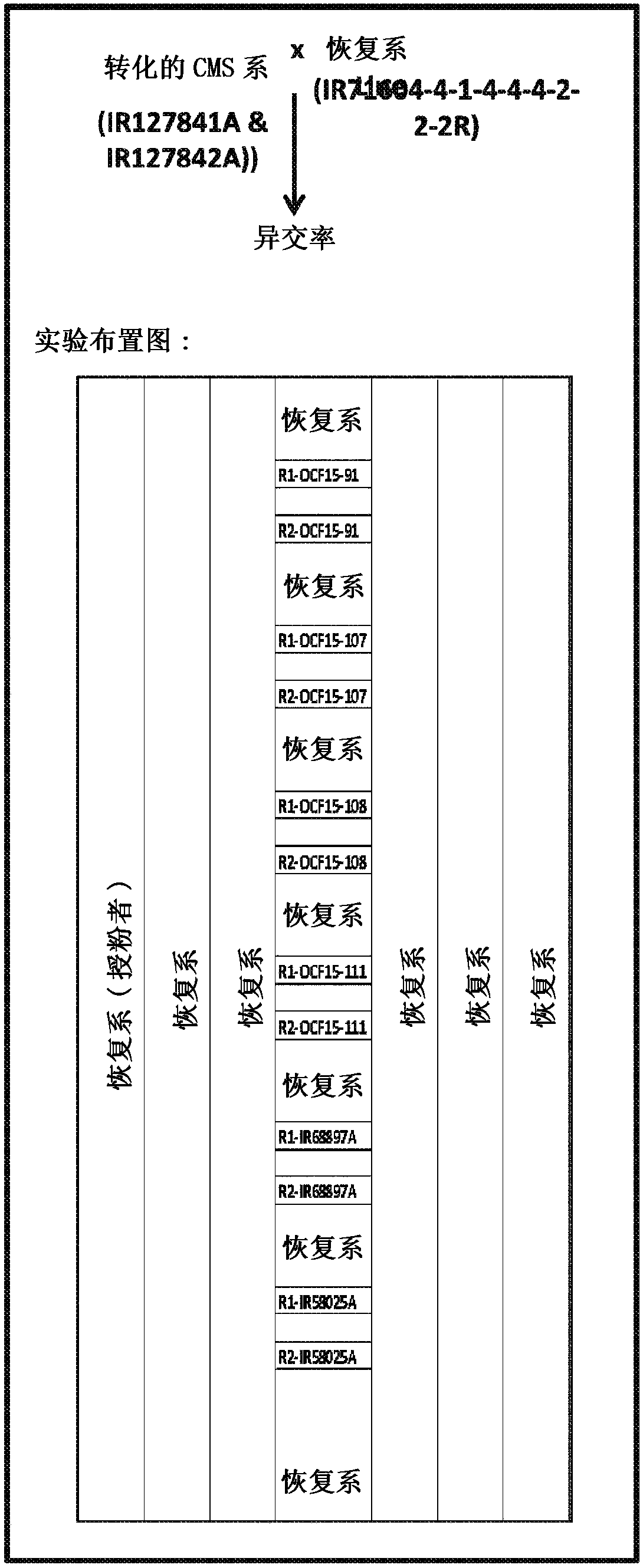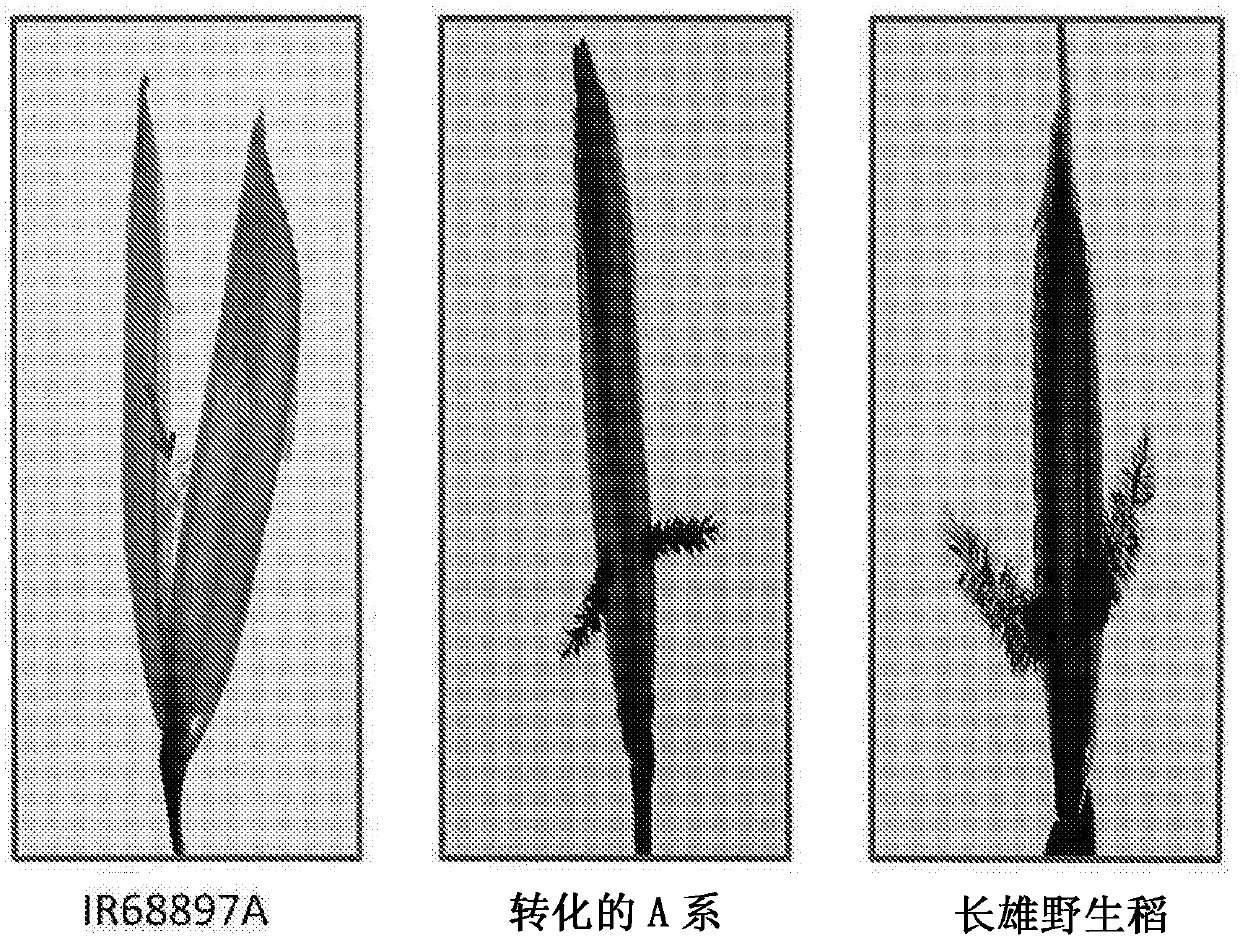Increasing hybrid seed production through higher outcrossing rate in cytoplasmic male sterile rice and related materials and methods
A technology for male sterility and male sterility, which is applied in biochemical equipment and methods, botanical equipment and methods, plant regeneration, etc., can solve the problem of high cost of hybrid rice seeds, poor hybrid seed production, and low outcrossing rate question
- Summary
- Abstract
- Description
- Claims
- Application Information
AI Technical Summary
Problems solved by technology
Method used
Image
Examples
Embodiment approach
[0221] According to some exemplary embodiments, the DNA locus is a quantitative trait locus related to stigma length, which may be selected from: qSTGL2-1; qSTGL5-1; qSTGL8-1; qSTGL8-2 and qSTGL11-1. At least one marker of at least one O. longista quantitative trait locus associated with stigma length is selected from the group consisting of: RM110 (qSTGL2-1); RM421 (qSTGL5-1); RM7356 (qSTGL8-1); RM5353 (qSTGL8-1) RM256(qSTGL8-2); RM80(qSTGL8-2); RM590(qSTGL11-1); RM286(qSTGL11-1); RM120(qSTGL11-2) and RM229(qSTGL11-2).
[0222] In another embodiment described herein, at least one Oryza longista quantitative trait locus associated with total stigma and style length may be selected from: qPSTL1-1; qPSTL1-3; and qPSTL11-1. The at least one marker of at least one Oryza longista quantitative trait locus associated with total stigma and style length may be selected from: RM3604 (qPSTL1-1); RM3640 (qPSTL1-3); and RM5997 (qPSTL11-1).
[0223] Exemplary markers for validation of long...
Embodiment 1
[0240] Example 1. Characterization of pistil traits in Oryza species to identify wild species as donors for the transfer of floral traits affecting outcrossing
[0241]To understand the degree of variability in pistil traits, stigma length, stigma width, style length, and total stigma were identified in 47 accessions of Oryza 24 species covering 11 genomes, including cultivated rice and two unrelated plant species and style length (Table 1; Figure 10 ). No data were collected for O. schelcteri as it never flowered under tropical conditions. Cultivars of the O. sativa subspecies japonica have significantly shorter stigmas, styles, and total length than indica cultivars. Among the wild species with the AA genome, Oryza longistamina had significantly longer and wider stigma, style and total length than the other species. At the genome complex level, the Malayan rice (O. ridleyi) complex has significantly longer stigmas than the Asian rice (O. sativa) complex and the medicinal...
Embodiment 2
[0246] Example 2. Development of IR58025B maintainer line with long stigma
[0247] A cross was made between the maintainer line IR58025B and Oryza longistaminata (Accession No. 110404) to transfer the long stigma trait to the IR58025B background. in bc 1 f 1 , for 475 strains of BC from 12 crosses 1 f 1 Plants were evaluated for stigma length and lines with stigma length 50% greater than the backcross parent were selected and backcrossed to produce 46 BC 2 f 1 hybrid seeds. in bc 2 f 1 , 1653 strains of BC from 46 crosses were evaluated 2 f 1 plants and backcross with the respective backcross parents to produce 34 BC 3 f 1 seed. in bc 1 f 2 In , 944 plants were evaluated and 45 plants with longer stigmas were selected. in bc 2 f 2 In , 1109 plants were evaluated and 98 plants with longer stigmas were selected. Stigma lengths in different backcross generations ranged from 0.85 to 2.88 mm, while stigma+style lengths ranged from 2.22-4.57 mm (Table 2).
PUM
 Login to View More
Login to View More Abstract
Description
Claims
Application Information
 Login to View More
Login to View More - R&D
- Intellectual Property
- Life Sciences
- Materials
- Tech Scout
- Unparalleled Data Quality
- Higher Quality Content
- 60% Fewer Hallucinations
Browse by: Latest US Patents, China's latest patents, Technical Efficacy Thesaurus, Application Domain, Technology Topic, Popular Technical Reports.
© 2025 PatSnap. All rights reserved.Legal|Privacy policy|Modern Slavery Act Transparency Statement|Sitemap|About US| Contact US: help@patsnap.com



